Summer Camp 2025 Registration is Open – click here to register now!
Kids & Company Blog
Understanding how children at different ages learn
My name is Sarah Pumphrey and I've been working with children in their early years for the past 13 years. I worked overseas as a teacher in England and China then continued my career in the childcare sector here in Toronto. While working at Kids & Company, I've worked as a Preschool ECE, Assistant Director, Centre Director and now Curriculum Director for Toronto and the GTA. In 2017, I completed the Master of Education program in Developmental Psychology at the University of Toronto. I'm very interested in how children learn through play and also differentiating care and education for children with varying abilities.
I sat down and answered some burning questions below:
How is learning facilitated over different age groups in a childcare setting?
At Kids & Company, we believe play to be the most important factor in setting the stage for learning to occur. For all of our age groups we focus on learning through experience by setting out a variety of engaging activities and allowing the children to explore the materials in a child-directed way.
Our program is derived in the same way for all of our age groups. We observe the children’s interests and take into account how they are spending their time and for older children what they are talking about. In this way, we let the children guide us in creating new learning opportunities for them. For example, if an infant is engaged in crawling after a ball and tries rolling it on different surfaces we may plan an activity where they have the opportunity to roll balls down varying inclines. By focusing on the children’s interests, this creates a high level of engagement in our program.

INFANTS
Infants primarily learn through exploration of their surroundings. They especially enjoy sensory activities where they are able to experiment with different textures, sounds and tastes. We also teach infants through song and music which piques their interest and allows us to relay information in a fun and memorable way. I have often observed infants approach children to feel their hair in a gentle way. This is an example of an infant learning through touch in a developmentally appropriate way and also very sweet for us to observe!
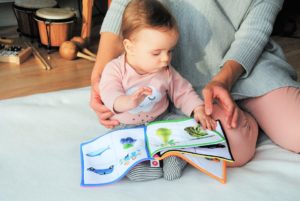
TODDLERS
Toddlers are at an age where they begin to display what we consider to be typical play behaviours. They will sit down with a material and mimic ways they have observed others interact with the item and also start to engage with it in novel ways. The teachers in our toddler classrooms focus on interacting with the children during these experiences and encourage them to continue to manipulate the material and at times test the limits of that item. Depending on the verbal abilities of the toddler, the teacher may decide to use non-verbal or verbal cues during this play interaction with the child.
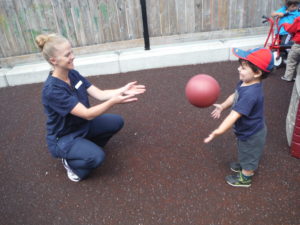
PRESCHOOL
In our preschool classrooms, a lot of evidence that the child has learned is demonstrated through what they create (i.e. a piece of art work), through verbal communication (i.e. telling another child a new experience that occurred during their weekend) and through play. It is often clear what the child is interested in as they are competent with different modes of communication at this age.
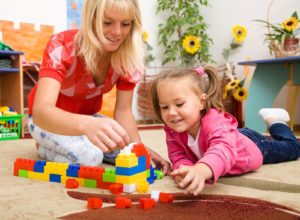
AGES & STAGES OF PLAY:
Newborn to 4 months - Play is primarily directed by parents, as infants are limited in their skills. Play involves a lot of face-to-face games, such as “PEEK-A-BOO.” Infants develop the ability to track and eventually grasp objects.
4 months to 8 months - Babies begin to engage in sensory-motor play, which involves exploring objects through different senses, particularly their mouths! “Joint attention” emerges, meaning the ability for a child to understand the parent is looking at what he is looking at.
9 months to 12 months - Babies start to move and engage in exploratory play. Symbolic play also emerges around 12 months, meaning children begin to understand that one object symbolizes another. (For example - a toy car represents an actual car).
12 months to 36 months - As language develops so does symbolic play. Children are able to use one object to symbolize another unrelated object. (For example – they can pretend that a block is flying spaceship). Children engage in parallel play with other children, meaning they play alongside each other rather than with each other.
3 years to 5 years - Children engage in cooperative play, which primarily involves lots of pretend play whereby children make up and play out imaginary scenarios together. Turn-taking occurs.
5 years and up - Children are capable of playing games together that involve an agreed upon set of rules.
How do we use our proprietary programs to foster growth and development?
We are happy to offer different proprietary activities, including our Alpha-Mania and Mini Master programs, to our Toddler and Preschool age groups. We facilitate these programs in small groups similar to how we deliver our play-based program. To begin, children are typically invited to a small group circle during which the mini-lesson on the letter of the week or a piece of art takes place. These small group learning experiences are fun and interactive; the children are given several opportunities to contribute their thoughts and comments. Following this, a variety of learning experiences are set out for the children to take part in if they choose, usually including an art activity, fine motor activity and a musical/gross motor activity. We have found that by providing activities to the children on the same topic in varying ways, it serves to solidify the children’s knowledge on the letter or piece of art. Through these lessons, we often introduce novel information which the children can then generalize to other situations in their lives whether it be at child care or at home.
When I was a Preschool teacher at our Islington location in Ontario, I had a child in my class who was engrossed in our weekly Mini Master program. He loved the artist Michelangelo and was inspired to produce his own art based on the work of this Master for lengthy periods of time. After we finished the Michelanglo unit and moved onto another artist, he approached me and told me, “I prefer Michelanglo!” This showed me that not only had he enjoyed the past month of Mini Master lessons, but that he developed the ability to judge what art work he preferred, which I found amazing for a child of 4 years of age!
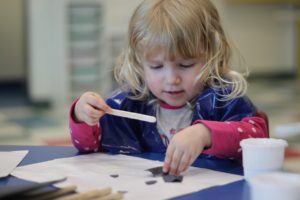
What are the different learning styles and how do our teachers cater to each of them?
As explained on the Education Corner website, there are four main styles of learning. From an early age we often notice children display a preference for a specific mode or modes of learning.
Visual learners acquire knowledge optimally through observing images or a skill being demonstrated for them. These children usually visualize and recall images when learning through play. Visual learners usually prefer an uncluttered environment so they can focus on the visual stimuli involved in their learning experience. At Kids & Company we post the children’s work on a limited amount of bulletin boards in the room to avoid having a visually busy environment.
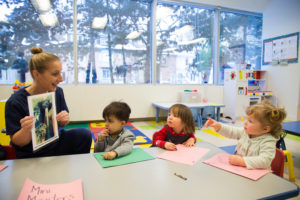
Auditory learners prefer information to be delivered through music and sounds. This is a mode of learning we are constantly catering to in our program. Teachers plan songs that they will teach and practice with the children daily. Additionally, we often use songs to facilitate the transition from one activity to the next, for example, a tidy up song to signal to the children it’s time for the play to stop and cleaning to begin. We also use song to guide children through daily routines, such as a simple song about walking to toddlers making their way down the hallway to the playground.
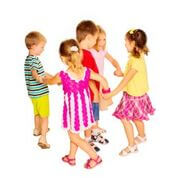
Some children’s strongest learning style preference is verbal, which occurs through spoken or written word. We facilitate multiple small group circles in each of our classrooms during the day. This is our opportunity to teach new information to the children and extend upon their interests. Having a small group of children involved in the circle allows for each child to have the chance to contribute their thoughts or ask questions. For toddlers this may be through a word they relate to the topic. Preschoolers love to ask questions and often help to answer each other’s queries during this time.

Lastly, some children learn best through touch and doing an activity independently. Rather than listening to how to complete a task, these children remember best by working on something in a hands-on manner. We link the children’s interests to our planned gross motor and movement activities, which are usually pursuits that kinesthetic learners prefer.
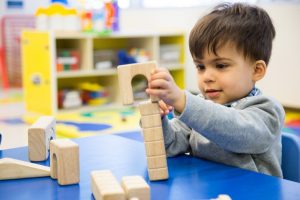
Source: https://www.educationcorner.com/learning-styles.html
Sarah is the Kids & Company Curriculum Director for Toronto and the GTA. She is very interested in how children learn through play and also differentiating care and education for children with varying abilities. Connect with her at spumphrey@kidsandcompany.com!
Posted on: Thursday March 14th, 2019
Posted by: Kids & Company
Calgary
Calgary
Calgary
Calgary
Calgary
Edmonton
Cochrane
Red Deer
Calgary
Calgary
Okotoks
Calgary
Calgary
Calgary
Calgary
Edmonton
St. Albert
Edmonton
Edmonton
Edmonton
Edmonton
Edmonton
Edmonton
Edmonton
St. Albert
Edmonton
Edmonton
Sylvan Lake
Edmonton
Sherwood Park
Edmonton
Calgary
Edmonton
Calgary
Edmonton
Kamloops
Langley
Langley
New Westminster
North Vancouver
Richmond
Vancouver
Victoria
Victoria
Port Moody
Surrey
Surrey
Surrey
North Vancouver
Nanaimo
Surrey
Coquitlam
Burnaby
Port Coquitlam
Vancouver
Maple Ridge
Maple Ridge
Maple Ridge
Mission
Maple Ridge
Maple Ridge
Maple Ridge
Maple Ridge
Mission
Mission
Maple Ridge
Maple Ridge
Chicago
Chicago
Chicago
Chicago
Schaumburg
Chicago
Winnipeg
Abington
Canton
Quincy
West Quincy
Braintree
Braintree
Walpole
East Walpole
Brighton
Brookline
Jamaica Plain
Jamaica Plain
Cambridge
Needham
Newton Highlands
Newton
Cambridge
Boston
Randolph
Kingston
St. Peters
Lake St. Louis
Troy
O'Fallon
St. Charles
Lake St. Louis
St. Peters
O'Fallon
Howell Township
Freehold Township
Manalapan Township
Stratford
Marlton
West Deptford
Bedford
Dartmouth
Halifax
Bedford
Hammonds Plains
Lower Sackville
Eastern Passage
Avon Lake
Beachwood
Hudson
Medina
Strongsville
Cleveland
Westlake
Aurora
Burlington
Burlington
Etobicoke
Etobicoke
Hamilton
London
Milton
Mississauga
Ottawa
Richmond Hill - Corporate office (No child care services)
Toronto
Toronto
Toronto
Toronto
Toronto
Waterloo
Kanata
Oakville
Oakville
Toronto
Whitby
Toronto
Mississauga
Ottawa
Toronto
Toronto
Toronto
Brampton
Stoney Creek
Toronto
Nepean
Burlington
Burlington
Oakville
Waterdown
Oakville
Pittston
Wilkes-Barre
Exeter
Old Forge
Dover
Harrisburg
Harrisburg
Harrisburg
Hummelstown
Palmyra
York
York
York
Sweet Kiddles Avon Lake, part of the Kids & Company Family
Abington
Aurora
Sweet Kiddles Beachwood, part of the Kids & Company Family
Bedford (Dellridge Lane)
Larry Uteck (Southgate Dr)
Pine Village South End, by Kids & Company
Braintree 1
Braintree 2
Brampton
Pine Village Brighton, by Kids & Company
Pine Village Brookline, by Kids & Company
Burlington Children’s Centre
Burloak
Appleby
Beacon Hill
Brightstart Burnaby, by Kids & Company
Bow Trail
Livingston
Midlake
Millrise
Royal Oak
Britannia Crossing
Marda Loop
Evanston
Beltline
Aviation Crossing
Gulf Canada Square
Royal Oak Out of School Care and Child Care
Glendeer: New – Open for Enrollment
Pine Village Kendall Square, by Kids & Company
Pine Village Porter Square, by Kids & Company
Canton
Jackson
Lincoln Park
Harrison
West Loop
Fulton
Sweet Kiddles University Circle, part of the Kids & Company Family
Cochrane
Brightstart Coquitlam, by Kids & Company
Dartmouth
Dover
Walpole North
Eastern Passage
Ellerslie
Edmonton Ice District
Baturyn
Diamond
Friendly Frog
Meadowlark Park
St. Charles
St. Dominic
Sunshine Factory
Tamarack
Jagare Ridge
Horse Hill
Fraser
Century Park: New – Open for Enrollment
Grandview Heights: New – Open for Enrollment
Islington
Etobicoke (Bloor & Islington)
ABC Kiddie Kampus Exeter, by Kids & Company
Apple Hill Academy Freehold by Kids & Company
Halifax
Hamilton
Hammonds Plains
Route 39
Schaffner
Swatara
Apple Hill Academy Howell by Kids & Company
Sweet Kiddles Hudson, part of the Kids & Company Family
Hummelstown
Pine Village JP Revere, by Kids & Company
Pine Village JP South Street, by Kids & Company
Kamloops
Eagleson (South Kanata)
Crayon College, by Kids & Company
Tyke Town Lake St. Louis, by Kids & Company
ABC Lake St. Louis, by Kids & Company
Kids World
Langley (200th St.)
London Richmond
Sackville
Apple Hill Academy Manalapan by Kids & Company
119 Avenue, Part of the Kids & Company Family
Dewdney House (Infant/Toddler and 3-5), Part of the Kids & Company Family
Dewdney Church (Preschool/OSC/3-5), Part of the Kids & Company Family
Edge, Part of the Kids & Company Family
Webster’s Corner, Part of the Kids & Company Family
Harry Hooge, Part of the Kids & Company Family
Alouette, Part of the Kids & Company Family
Silver Valley, Part of the Kids & Company Family
Whonnock, Part of the Kids & Company Family
Under The Sun Marlton, part of the Kids & Company Family
Sweet Kiddles Medina, part of the Kids & Company Family
Milton
Lougheed, Part of the Kids & Company Family
Stave Falls, Part of the Kids & Company Family
Briskham, Part of the Kids & Company Family
Robert Speck Parkway
Mississauga Gateway Centre
Nanaimo
Pine Village Needham, by Kids & Company
Ottawa Barrhaven
New Westminster
Pine Village West Newton, by Kids & Company
Pine Village Newton Highlands, by Kids & Company
North Vancouver
North Van Esplanade
O’Fallon South
ABC O’Fallon, by Kids & Company
Oakville Cornwall
Oakville Dundas
Joshua Creek
Oakville West (3471 Wyecroft Rd)
Okotoks
ABC Kiddie Kampus Old Forge, by Kids & Company
Ottawa Albert
Ottawa Westboro
Palmyra
ABC Kiddie Kampus Pittston, by Kids & Company
Brightstart Port Coquitlam, by Kids & Company
Port Moody
Marina Bay
Randolph
Red Deer
Richmond
Head Office
Schaumburg
Sherwood Park
St. Albert North
St. Albert Grandin
ABC St. Charles, by Kids & Company
Tyke Town St. Peters, by Kids & Company
ABC St. Peters, by Kids & Company
Stoney Creek
Under The Sun Stratford, part of the Kids & Company Family
Sweet Kiddles Strongsville, part of the Kids & Company Family
Morgan Crossing
Surrey Professional Centre
King George
Brightstart Cloverdale, by Kids & Company
Sylvan Lake
Bloor Christie
Bloor (Bloor St. East)
Consumers
Finch
Front
Scotia Plaza
Stockyards
St. Andrew’s Church
Liberty Village
Rosedale
Queen West
Tyke Town Troy, by Kids & Company
Vancouver West
Cambie
Langford
Victoria
Walpole South
Waterdown
Tech Town
Under The Sun West Deptford, part of the Kids & Company Family
West Quincy
Sweet Kiddles Westlake, part of the Kids & Company Family
Whitby
ABC Kiddie Kampus East Mountain, by Kids & Company
Winnipeg
West York
Queen Street
Keystone Early Learning Academy, part of the Kids & Company Family
Calgary
Calgary
Calgary
Calgary
Calgary
Edmonton
Cochrane
Red Deer
Calgary
Calgary
Okotoks
Calgary
Calgary
Calgary
Calgary
Edmonton
St. Albert
Edmonton
Edmonton
Edmonton
Edmonton
Edmonton
Edmonton
Edmonton
St. Albert
Edmonton
Edmonton
Sylvan Lake
Edmonton
Sherwood Park
Edmonton
Calgary
Edmonton
Calgary
Edmonton
Kamloops
Langley
Langley
New Westminster
North Vancouver
Richmond
Vancouver
Victoria
Victoria
Port Moody
Surrey
Surrey
Surrey
North Vancouver
Nanaimo
Surrey
Coquitlam
Burnaby
Port Coquitlam
Vancouver
Maple Ridge
Maple Ridge
Maple Ridge
Mission
Maple Ridge
Maple Ridge
Maple Ridge
Maple Ridge
Mission
Mission
Maple Ridge
Maple Ridge
Chicago
Chicago
Chicago
Chicago
Schaumburg
Chicago
Winnipeg
Abington
Canton
Quincy
West Quincy
Braintree
Braintree
Walpole
East Walpole
Brighton
Brookline
Jamaica Plain
Jamaica Plain
Cambridge
Needham
Newton Highlands
Newton
Cambridge
Boston
Randolph
Kingston
St. Peters
Lake St. Louis
Troy
O'Fallon
St. Charles
Lake St. Louis
St. Peters
O'Fallon
Howell Township
Freehold Township
Manalapan Township
Stratford
Marlton
West Deptford
Bedford
Dartmouth
Halifax
Bedford
Hammonds Plains
Lower Sackville
Eastern Passage
Avon Lake
Beachwood
Hudson
Medina
Strongsville
Cleveland
Westlake
Aurora
Burlington
Burlington
Etobicoke
Etobicoke
Hamilton
London
Milton
Mississauga
Ottawa
Richmond Hill - Corporate office (No child care services)
Toronto
Toronto
Toronto
Toronto
Toronto
Waterloo
Kanata
Oakville
Oakville
Toronto
Whitby
Toronto
Mississauga
Ottawa
Toronto
Toronto
Toronto
Brampton
Stoney Creek
Toronto
Nepean
Burlington
Burlington
Oakville
Waterdown
Oakville
Pittston
Wilkes-Barre
Exeter
Old Forge
Dover
Harrisburg
Harrisburg
Harrisburg
Hummelstown
Palmyra
York
York
York
Sweet Kiddles Avon Lake, part of the Kids & Company Family
Abington
Aurora
Sweet Kiddles Beachwood, part of the Kids & Company Family
Bedford (Dellridge Lane)
Larry Uteck (Southgate Dr)
Pine Village South End, by Kids & Company
Braintree 1
Braintree 2
Brampton
Pine Village Brighton, by Kids & Company
Pine Village Brookline, by Kids & Company
Burlington Children’s Centre
Burloak
Appleby
Beacon Hill
Brightstart Burnaby, by Kids & Company
Bow Trail
Livingston
Midlake
Millrise
Royal Oak
Britannia Crossing
Marda Loop
Evanston
Beltline
Aviation Crossing
Gulf Canada Square
Royal Oak Out of School Care and Child Care
Glendeer: New – Open for Enrollment
Pine Village Kendall Square, by Kids & Company
Pine Village Porter Square, by Kids & Company
Canton
Jackson
Lincoln Park
Harrison
West Loop
Fulton
Sweet Kiddles University Circle, part of the Kids & Company Family
Cochrane
Brightstart Coquitlam, by Kids & Company
Dartmouth
Dover
Walpole North
Eastern Passage
Ellerslie
Edmonton Ice District
Baturyn
Diamond
Friendly Frog
Meadowlark Park
St. Charles
St. Dominic
Sunshine Factory
Tamarack
Jagare Ridge
Horse Hill
Fraser
Century Park: New – Open for Enrollment
Grandview Heights: New – Open for Enrollment
Islington
Etobicoke (Bloor & Islington)
ABC Kiddie Kampus Exeter, by Kids & Company
Apple Hill Academy Freehold by Kids & Company
Halifax
Hamilton
Hammonds Plains
Route 39
Schaffner
Swatara
Apple Hill Academy Howell by Kids & Company
Sweet Kiddles Hudson, part of the Kids & Company Family
Hummelstown
Pine Village JP Revere, by Kids & Company
Pine Village JP South Street, by Kids & Company
Kamloops
Eagleson (South Kanata)
Crayon College, by Kids & Company
Tyke Town Lake St. Louis, by Kids & Company
ABC Lake St. Louis, by Kids & Company
Kids World
Langley (200th St.)
London Richmond
Sackville
Apple Hill Academy Manalapan by Kids & Company
119 Avenue, Part of the Kids & Company Family
Dewdney House (Infant/Toddler and 3-5), Part of the Kids & Company Family
Dewdney Church (Preschool/OSC/3-5), Part of the Kids & Company Family
Edge, Part of the Kids & Company Family
Webster’s Corner, Part of the Kids & Company Family
Harry Hooge, Part of the Kids & Company Family
Alouette, Part of the Kids & Company Family
Silver Valley, Part of the Kids & Company Family
Whonnock, Part of the Kids & Company Family
Under The Sun Marlton, part of the Kids & Company Family
Sweet Kiddles Medina, part of the Kids & Company Family
Milton
Lougheed, Part of the Kids & Company Family
Stave Falls, Part of the Kids & Company Family
Briskham, Part of the Kids & Company Family
Robert Speck Parkway
Mississauga Gateway Centre
Nanaimo
Pine Village Needham, by Kids & Company
Ottawa Barrhaven
New Westminster
Pine Village West Newton, by Kids & Company
Pine Village Newton Highlands, by Kids & Company
North Vancouver
North Van Esplanade
O’Fallon South
ABC O’Fallon, by Kids & Company
Oakville Cornwall
Oakville Dundas
Joshua Creek
Oakville West (3471 Wyecroft Rd)
Okotoks
ABC Kiddie Kampus Old Forge, by Kids & Company
Ottawa Albert
Ottawa Westboro
Palmyra
ABC Kiddie Kampus Pittston, by Kids & Company
Brightstart Port Coquitlam, by Kids & Company
Port Moody
Marina Bay
Randolph
Red Deer
Richmond
Head Office
Schaumburg
Sherwood Park
St. Albert North
St. Albert Grandin
ABC St. Charles, by Kids & Company
Tyke Town St. Peters, by Kids & Company
ABC St. Peters, by Kids & Company
Stoney Creek
Under The Sun Stratford, part of the Kids & Company Family
Sweet Kiddles Strongsville, part of the Kids & Company Family
Morgan Crossing
Surrey Professional Centre
King George
Brightstart Cloverdale, by Kids & Company
Sylvan Lake
Bloor Christie
Bloor (Bloor St. East)
Consumers
Finch
Front
Scotia Plaza
Stockyards
St. Andrew’s Church
Liberty Village
Rosedale
Queen West
Tyke Town Troy, by Kids & Company
Vancouver West
Cambie
Langford
Victoria
Walpole South
Waterdown
Tech Town
Under The Sun West Deptford, part of the Kids & Company Family
West Quincy
Sweet Kiddles Westlake, part of the Kids & Company Family
Whitby
ABC Kiddie Kampus East Mountain, by Kids & Company
Winnipeg
West York
Queen Street
Keystone Early Learning Academy, part of the Kids & Company Family










